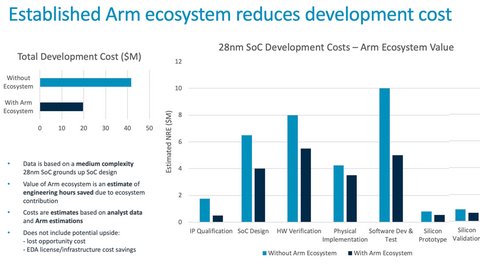The Arm Ecosystem: More than Just an Ecosystem, it's Oxygen for SoC Design Teams
April 10, 2019 -- If you are familiar with Arm, you have likely read or heard the term "Arm Ecosystem" at some point. You would be hard-pressed to find any Arm collateral, whether it’s a blog like this one, a press release, web page or white paper, that doesn’t refer to the Arm Ecosystem. And why shouldn’t we? No other business ecosystem comes close to this group of silicon, system and software companies responsible for shipping more than 130 billion Arm-based chips to-date.
And while I was reading the first sentence in a recently published white paper by The Linley Group stating, "Having shipped in more than 130 billion chips, the Arm architecture has become as familiar as breathing to many SoC designers," it struck me that the Arm Ecosystem is more than just the world’s largest compute ecosystem. It is shared oxygen for SoC designers.
I became more convinced of this after reading the entire whitepaper, titled "Arm Ecosystem Reduces SoC Design Cost and Time to Market." The paper looks at the near-immeasurable value the Arm Ecosystem provides SoC design teams throughout key points of the design cycle including verification and physical design.
The paper also details the role of the ecosystem in creating standards in support of chip-level security and functional safety. And perhaps most important, it discusses the software and tools investments made by Arm and its ecosystem to ensure compatibility across both the Arm ISA and processor implementations, helping the entire ecosystem avoid having to use the dreaded f-word: Fragmentation.

Take a few minutes to go to The Linley Group site and read the paper. Especially if you’re planning new embedded or deeply embedded silicon projects where SoC averaging selling prices can often be in cents, not dollars. After reading it you will have a better understanding of how the shared oxygen of the Arm Ecosystems can help in balancing innovation with maximizing TCO and margins.
Earlier I mentioned the "near-immeasurable value" the Arm Ecosystem provides SoC design teams. That may have been a bit too strong as we were recently able to gather data from both our ecosystem and third-party research that quantifies the estimated SoC design costs with and without the support of the Arm ecosystem. I’ll close by letting the numbers speak themselves.

About Arm
Arm technology is at the heart of a computing and connectivity revolution that is transforming the way people live and businesses operate. Our advanced, energy-efficient processor designs have enabled intelligent computing in more than 130 billion chips. More than 70% of the world’s population are using Arm technology, which is securely powering products from the sensor to the smartphone to the supercomputer. This technology combined with our IoT software and end-to-end connectivity, device and data management platform enables customers to derive real business value from their connected devices and data. Together with our 1,000+ technology partners we are at the forefront of designing, securing and managing all areas of compute from the chip to the cloud.
Related Semiconductor IP
- Ultra-Low-Power LPDDR3/LPDDR2/DDR3L Combo Subsystem
- 1G BASE-T Ethernet Verification IP
- Network-on-Chip (NoC)
- Microsecond Channel (MSC/MSC-Plus) Controller
- 12-bit, 400 MSPS SAR ADC - TSMC 12nm FFC
Related Blogs
- Expanded access to Arm Virtual Hardware for the entire IoT ecosystem
- Arm Ecosystem Collaborates on Standards to Enable a Thriving Chiplet Market
- Ecosystem Collaboration Drives New AMBA Specification for Chiplets
- Extending Arm Total Design Ecosystem to Accelerate Infrastructure Innovation
Latest Blogs
- Rivian’s autonomy breakthrough built with Arm: the compute foundation for the rise of physical AI
- AV1 Image File Format Specification Gets an Upgrade with AVIF v1.2.0
- Industry’s First End-to-End eUSB2V2 Demo for Edge AI and AI PCs at CES
- Integrating Post-Quantum Cryptography (PQC) on Arty-Z7
- UA Link PCS customizations from 800GBASE-R Ethernet PCS Clause 172
